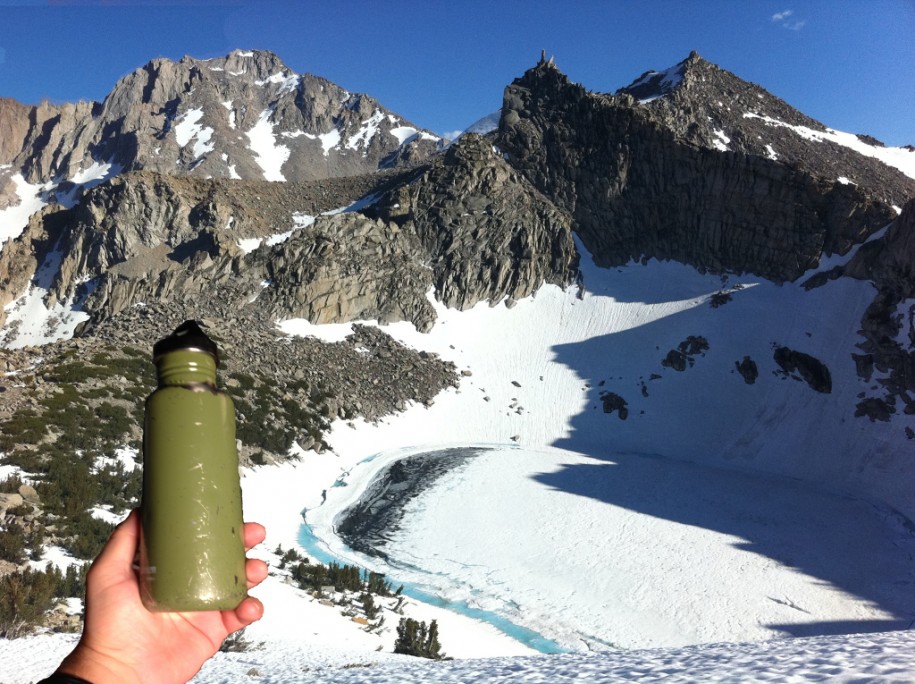Altitude Sickness
31 Aug
Laying by the side of the trail for the past half hour, ridge in sight, heart racing uncontrollably, I came to the inevitable conclusion that I was indeed suffering from altitude sickness and I’d have to get down as soon as possible.
Jason, Zee and I had been attempting to cross Kersarge Pass just a week prior to starting the Muir Trail in order to drop off the last cache of food which would be dependent upon almost one month later. While they had driven up and camped at the Onion Valley campground (a 9,189 ft campsite, which in and of itself is pretty darn high) the evening before, I had stupidly decided that I could handle driving from sea level to crossing an 11,760 ft pass in less than a day. I had hiked in the same area numerous times prior to this, and hadn’t even considered that this could happen to me. Fortunately, this was not Everest and my situation, while incredibly unpleasant and very unnerving, was not life threatening. My experience with altitude sickness resulted in an uncontrollably fast heart rate, which I could not slow despite my best efforts, as well as intense naseau which almost ended with me losing my lunch into Jason’s water bottle.
As defined on Wikipedia, “Altitude sickness—also known as acute mountain sickness (AMS), altitude illness, hypobaropathy, or soroche—is a pathological effect of high altitude on humans, caused by acute exposure to low partial pressure of oxygen at high altitude. It commonly occurs above 2,400 metres (8,000 feet). It presents as a collection of nonspecific symptoms, acquired at high altitude or in low air pressure, resembling a case of “flu, carbon monoxide poisoning, or a hangover”. It is hard to determine who will be affected by altitude sickness, as there are no specific factors that correlate with a susceptibility to altitude sickness.”
AMS should not be taken lightly. Without the help of Jason and Zee, it would have taken at least twice as long for me to reach the trailhead where we had begun our hike. While I probably have not suffered anything worse than feeling terrible, at higher elevations altitude sickness can result in life threatening situations such as cerebral edema, where your brain swells, and pulmonary edema, where your lungs fill with fluid. The only way to completely counteract the effects of AMS is to get to a lower elevation, preferably as fast and as low as possible. If you plan on hiking in a place which immediately puts you at a high elevation (as we did), it is highly recommended that you spend a day or two acclimating at a higher elevation than you would normally be. For example, living at sea level, I definitely should have spent a day at the campsite at 9,189 ft, where I would not be over exerting myself. If this isn’t a possibility, you can also go see a regular physician, or a travel clinic, and they will be able to provide further information on ways to help lessen the symptoms for the first few days of your trip.
Before this incident, I prided myself on being immune to conditions like this, a statement which I realize in hindsight oozes with ignorant bravado. As I get older my body reacts to situations much differently than it used to, and I should have played the “better safe than sorry” game that I usually do. Preparation is crucial before a trip to a foreign place and will always result in a more enjoyable experience. I was fortunate that my situation ended only in a recurring joke when in the near proximity of Jason’s water bottle…and then food poisoning…a week before heading out on a month long hike…but that’s a blog entry for another time.
Please note: IN NO WAY SHOULD THE MUIR PROJECT BE CONSIDERED AS OFFERING MEDICAL ADVICE! THE CONTENT ON THE SITE IS PRESENTED FOR INFORMATIONAL/ENTERTAINMENT PURPOSES ONLY. NEVER DISREGARD MEDICAL ADVICE OR DELAY IN SEEKING IT BECAUSE OF SOMETHING YOU HAVE READ ON THE SITE!
